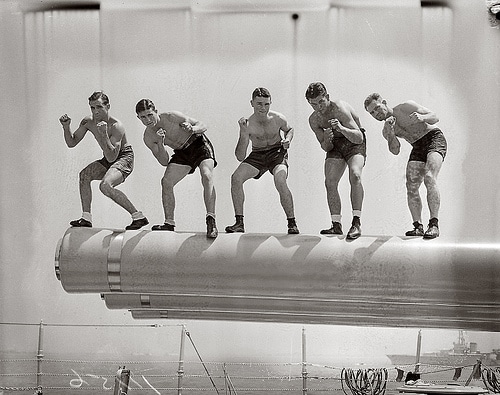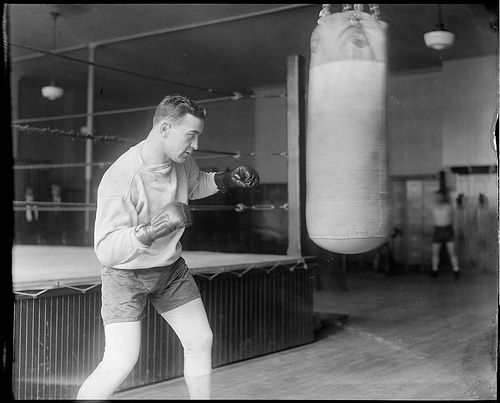
Editors note: This is a guest post from Chad Howse.
Last week we talked about two components of a fighter’s training regimen: running/sprinting and plyometrics. Today we’re going to talk about the two other main ingredients in a fighter’s fitness plan: weight training and bag work.
There are a couple schools of thought in regards to weight training for fighters. Members of the “old school,” especially, feel that weight training only builds muscle mass, tightening the body, while leaving a fighter less effective in the ring. Even less powerful.
There are those, however, that see the benefits of weight training in combat sports: the improved power, speed, and muscular endurance that we gain from proper weight training. Today we’re going to focus on a proper method for a fighter to train with weights.
The purpose of weight training for a fighter is twofold:
- To improve power and explosiveness
- To improve muscular endurance
Gaining muscle mass is of little benefit to a fighter. Muscles consume more oxygen and require more blood-flow than fat. So hypertrophy – or muscle building sets – and tempos aren’t part of a fighter’s workout.
But, by focusing on lower, power repetition counts, and higher, muscular endurance rep counts, fighters build some of the best physiques in sport – which is exactly what we’ll be focusing on in today’s workout.
How to Train Like a Fighter: Weight Training and Bag Work
Weight Training
Weight Training Tips:
1. Everything is done at full speed while still being in control of the weight you’re lifting, pressing, or pulling. Good form comes first. Then, and only then, should we work on exploding with the weight.
This is especially true for the concentric contraction of each exercise. You’re always going at full speed on this phase of each exercise (press in a bench press, pull in a chin-up, lift in a deadlift).
2. Work hard! The thing that separates how the best fighters train isn’t what they do, but how they do it. Yes, they do things a little differently as far as choosing exercises and the reps they use. But the work ethic is where a fighter is truly unique.
Treat each set as if it’s the one and only set of the workout. Don’t “pace yourself” for a big finish.
Set Descriptions:
A1. A2. = Superset. Do both exercises back-to-back, with the rest period coming at the end of the set. Repeat for however many sets are shown.
B1. B2. B3. = Giant Set. Do all 3 exercises back-to-back with the rest period coming at the end of the set. Repeat for however many sets are shown.
C1.C2.C3.C4. = Quad Set. Perform all 4 exercises back-to-back with the rest period coming at the end of the set. Repeat for however many sets are shown.
Workout #1 – Lower Body Dominated
Warm-up: 10 minutes of skipping
Superset #1
A1. Hack Squat – Reps: 8,6,4,6,8
A2. Dumbbell Snatch – Reps: 8,6,4,6,8
Rest: 60 secondsGiant Set #2
B1. Deadlifts – Reps: 10,10,10
B2. Weighted Box Jump – Reps: 8,8,8
B3. Box Jumps – Reps: 6,6,6
Rest: 45 secondsSuperset #3
C1. Quarter Squat – Reps: 15,20,25
C2. Squat Jumps – Reps: 15,15,15Abs
Decline Weighted Sit-ups – Reps: 15,15,15
Roll-outs – Reps: 15,15,15
Workout #2 – Upper Body Dominated
Warm-up: 10 minutes of skipping
Superset #1
A1. Lumberjack Press: 14,14,14
A2. Bent-over Row – 12,12,12
Rest: 60 secondsGiant Set #2
B1. Pull-ups – Reps: 10,10,10
B2. Walking Push-Ups – Reps: 10,10,10
B3. Alternating Med-Ball Push-ups – Reps: 10,10,10
Rest: 45 secondsQuad Set #3
C1. Dips – failure x 3
C2. Inverted Row – failure x 3
C3. Power Curl – Reps: 6,6,6
C4. Power Row – 6,6,6
Rest: 45 secondsBurnout Set
1 Set of 30 barbell punches
Bag Work

Typically a “bag drill” will be split into rounds with 60-seconds of rest in-between the rounds, mimicking a fight. This is what we’re going to do here. I’ll show a few examples of combinations you can use during the round, and then finish off with an interval drill to end the workout.
Bag Work Tips:
1. Pretend like you’re getting hit back. A big mistake we make when hitting the bag is focusing completely on offense. We then take that into a fight, throwing punches but failing to move out of the way after the punch is thrown.
Even though we’re just hitting the heavy bag, always keep your head moving. Act as if the bag can hit back. Bob your head. Finish a combination with a couple jabs while circling the target. Never go front to back — always move in circles.
2. Add defense to your combinations. When throwing combinations, don’t just throw punches, add some blocking into the drill as well.
Workout:
Bag Drill Tempo #1:
- 5 rounds (3 minutes a piece with 60 seconds between rounds)
- Focus on a few combinations within each round.
- Finish the last 30 seconds of each round going all out (no set combination being practiced). Punch as hard and as fast as possible with straight left and right punches.
Bag Drill Tempo #2:
- Beginner: 5 seconds fast and hard straight rights and lefts; 5 seconds rest. Repeat for 3 minutes, then 60 seconds rest. Continue for 3 rounds.
- Advanced: 10 seconds of assorted punches thrown at full speed/power; 5 seconds rest. Repeat for 3 minutes, followed by a 60-second rest. Repeat for 3 rounds or more (try and vary your combinations as much as possible. Don’t just throw straight rights and lefts).
Here’s an example of a couple combinations you can use in your bag drills:
Train Like a Fighter Complete Program
Above are 3 workouts: a lower body dominated workout, an upper body dominated workout, and a bag workout.
The bag work we have here takes the place of the ring work a fighter will have; however, we’ll spend much less time on the bag as a fighter would in the ring.
Each weight training workout should be done twice a week (if you’re just starting out, only do each once a week). You want one to two full rest days, depending on your conditioning.
Here’s an example of what a week of training will look like. With three workouts a day, this is the very most you could do. But for less optimal results, and/or if you’re not looking for a true, full-on fighter workout, you can do your bag work after your run or weight workout, or again, if you’re a beginner, simply cut down the number of workouts overall and do each of the workouts just once a week:
Monday: Morning run + plyometrics. Afternoon bag work. Evening lower body lift.
Tuesday: Morning run + plyometrics. Afternoon bag work. Evening upper body lift.
Wednesday: Full Rest Day.
Thursday: Morning run. Afternoon bag work. Evening lower body lift.
Friday: Morning run + plyometrics. Afternoon bag work.
Saturday: Morning run. Afternoon bag work. Evening upper body lift.
Sunday: Full Rest Day (with a plyometrics option).
_______________________________________
Tags: Exercises


